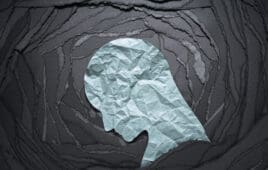
[Cariprazine image courtesy of PubChem]
In a post hoc analysis focusing on the adjunctive use of AbbVie’s dopamine D-preferring D3/D2 cariprazine in MDD patients with an inadequate response to one to three antidepressant therapies, patients saw a notable improvement in overall depressive symptoms and, specifically, anhedonia symptoms. This improvement, measured with the Montgomery-Åsberg Depression Rating Scale (MADRS), was observable as early as week 2 and persisted throughout the 6-week study duration. The study administered dosages of cariprazine at 1.5 mg/d and 3 mg/d, alongside standard antidepressant therapies.
“I would say that the takeaway is that there is an early response,” Maletic said. While it is too early to draw firm conclusions, “we can see that anhedonia continues to improve,” he added.
Background on cariprazine and the study in anhedonia
Initially developed through a collaboration between Allergan and Gedeon Richter, Vraylar (cariprazine) first won FDA approval in 2015 to manage acute manic or mixed episodes of bipolar I disorder and schizophrenia in adults. After that, it has secured further indications, including for schizophrenia maintenance in 2017 and bipolar depression in 2019. AbbVie secured rights to the drug in 2020, following its acquisition of Allergan. Fast forward to late 2022, Vraylar notched an FDA nod as an adjunctive therapy for major depressive disorder (MDD). With its broadened indications, AbbVie projects that cariprazine could amass up to $5 billion in peak sales by the decade’s end.
The anhedonia study involved a collaboration between the University of Toronto, the University of South Carolina School of Medicine, Duke-NUS in Singapore, and AbbVie in Madison, New Jersey.
Understanding anhedonia: Dopamine’s role
The results of the anhedonia study resonate with the current understanding of the neurobiology of anhedonia. Dr. Maletic emphasized, “The profile of the medication is rationally chosen. It’s not just a dartboard approach; it’s not about throwing everything at it to see what sticks.
The neurotransmitter perhaps most closely associated with anhedonia is dopamine. “It is dopamine signaling via the D3 receptor that is compromised in some way in depressed individuals,” Maletic noted. In individuals with MDD, dopamine release is dysregulated.
In response to a limited availability of dopamine, the receptors increase in number or sensitivity. That is, they are upregulated. “These are hungry receptors facing a scarcity of dopamine,” Maletic said.
“Functional imaging studies would suggest decreased dopamine release in the nucleus accumbens in these individuals and upregulated receptors,” Maletic said.
Recent research finds that the nucleus accumbens, a brain region closely linked to reward processing, relies on dopamine signaling. Anhedonia and its associated lack of motivation are thus associated with disruptions to this reward circuitry.
Cariprazine’s mechanism and potential in addressing anhedonia
While traditional antidepressants like SSRIs can help some patients by reducing distress by increasing serotonin, they have been less successful in addressing anhedonia.
Cariprazine is a D3 and D2 receptor partial agonist with a preference for the D3 receptor. “Cariprazine, at the D3 receptor, is approximately a 70% agonist,” Maletic said. “There are antiparkinsonian medications, such as ropinirole (also known as Requip) that operate similarly. These drugs have been studied in the context of depression and have shown efficacy in addressing symptoms, particularly in reducing anhedonic symptoms.”
Cariprazine is also a partial agonist at the serotonin 5-HT1A receptor and an antagonist at 5-HT2B and 5-HT2A receptors. That fact, together with the drug’s high selectivity for the D3 receptor, make cariprazine promising in addressing both the distress and anhedonic symptoms prevalent in MDD.
Successfully targeting anhedonia could potentially shift the MDD treatment landscape. Intensity of anhedonia is correlated with intensity of depression in MDD. And the potential of medications to reduce anhedonia could translate into higher response or remission rates. “Intensity of anhedonia is perhaps one of the strongest correlates of suicidal ideation,” Maletic noted.
Real-world observations
Beyond the confines of controlled studies, Maletic said he has seen promising results in patients treated with cariprazine, especially those who previously struggled with intractable anhedonia despite trying multiple therapies. “I have patients who are on cariprazine for several years, where there have been multiple attempts to address anhedonia with other agents that were unsuccessful, and they had a good response to cariprazine,” he said. Some of those patients have shown multiple years of improvement. “Many of these individuals are on three or four different agents. It’s hard to be decisive and say it’s the cariprazine making the difference,” Maletic said. “But [cariprazine] was the new addition to their regimen, and that seemed to result in improvement in anhedonnia.”
Possible future research directions
More data would be needed to scrutinize how the adjunctive use of cariprazine can influence comorbid symptoms like suicidal ideation. “What would be really nice is to start with the assumption that this medicine can help anhedonia, then study anhedonia and its changes with the medication and placebo prospectively, and then look at the correlates,” Maletic noted. “Is it correlated with a reduction in suicidal ideation? Is it correlated with improvements in functioning or quality of life?”
Maletic noted that a prospective study specifically targeting anhedonia could help shed light on such matters. “This study should examine overall improvement, remission rates, enhanced functioning, and quality of life. Ideally, it would be a long-term study, spanning at least six months,” he said.
The first aim of further research would be to see if the reduction in anhedonia is consistently achieved. The second will be to determine if the use of adjunctive cariprazine is associated with more sustained remission and improvements in quality of life and functionality? “Frankly, that’s what will keep the patients on the medicine,” Maletic said. “If you have medicine that can really help patients get well and stay well, that would be very important, not only for our patients, but for clinicians, too.”
Filed Under: clinical trials, Drug Discovery, Neurological Disease, Psychiatric/psychotropic drugs



